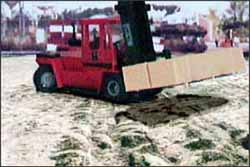Powered Industrial Trucks (Forklift) eTool
Understanding the Workplace » Physical Conditions

Surface or ground conditions are an important part of safe lift truck operation. Operating surfaces must be strong enough to support the forklift, its load and its operator. They must also be free of holes, grease, oil or obstructions that could cause the lift truck to skid or bounce, and possibly tipover.


Potential Hazards
-
Danger of skidding when traveling on oil, grease, water or other spills.
-
Danger of tipover when traveling on ice, snow, mud, gravel and uneven areas.
Requirements and Recommended Practices
-
Avoid the hazardous surface when feasible.
-
Spread absorbent material on slick areas that you cannot avoid.
-
Cross the slippery area slowly and cautiously.
-
Report the area to prevent others from slipping.
-
Post a sign or warning cones until the area can be cleaned.
-
Drive slowly! (Figure 2)
-
Maintain contact with the ground by crossing uneven areas at an angle. (Figure 3)
-
Clean up the oil or grease spill before proceeding. Driving over an oil or grease spot will enlarge the hazardous area.

Potential Hazards
-
Danger of tipover when traveling over obstructions.
-
Danger of tipover in holes and bumps.
Requirements and Recommended Practices
-
Keep all aisles clear.
-
Watch out for overhead obstructions.
-
Avoid the obstruction or get off the forklift and remove the obstruction. See Parking.
-
Never drive straight across speed bumps or railroad tracks. Cross slowly at a 45 degree angle.
-
Maintain steering control by keeping contact with the ground at all times.
-
If an area is cluttered, walk the route first to spot problems.
For additional information, see Operating a Forklift - Traveling & Maneuvering.

Potential Hazard
-
Danger of collapsing floor.
Requirements and Recommended Practices
-
Observe posted floor loading limits.
-
Inspect the condition of the floor. Look for holes or weakened flooring, loose objects or obstructions, protruding nails or boards.
-
Inform supervisor immediately if flooring is defective.
-
Do not travel over surface that cannot support the weight of the lift truck, its load and its operator.
-
Do not enter a box car or semi-van without inspecting its floor and knowing its load limits.
For additional information, see Load Handling: Operating the Forklift.

Potential Hazards
-
Damage to lights, stacks, doors, sprinklers, pipes.
-
Damage to load.
-
Danger of tipover.
Requirements and Recommended Practices
-
Be aware of the height of fixtures.
-
Do not travel with loads elevated.

